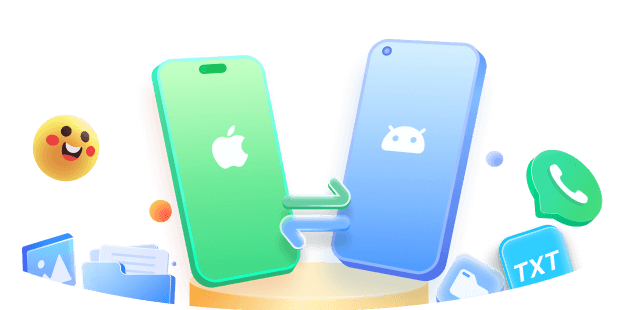Like an APK file on Android, an IPA file on iOS contains essential data for application installation and optimized backend running. You might find such files when installing custom apps outside the App Store and experimenting with their unique functionalities. Even though these files can open up new possibilities for accessing restricted apps, they also come with their own challenges.
This guide will explain everything about an IPA file for iOS, including how you can open or install it on your Apple devices without any risks. Similarly, we will explain how IPA files’ contents make it different from an APK file and provide a bonus tool to install such files on your device.
In this article
Part 1. What is an IPA File?
An IPA, or iOS Package App Store, is an application file extension for Apple devices. In short, these files contain compressed zipped data about applications that are to be installed on phones. Usually, app developers create these files to test new applications for bugs before pushing them into the App Store. In addition to beta testing, these files are helpful for enterprise app distribution.
For an average iOS user, such files are only as critical as installing third-party apps that are usually available on the App Store. You can download such files from iTunes or Apple Configurator 2. Additionally, you can also get these IPA files for iOS from unaffiliated third-party websites, even though they aren't the recommended resources for such things.
Part 2. What Does an IPA File Contains?
Since it is a zipped extension file, you can find different types of encoded data in it for the smooth functioning of the application. When you open an IPA file for iOS, you will typically find the following things within a package:
1.iTunes Artwork File
It is a high-resolution application icon that is to be displayed in the iOS interface. Usually, these are PNG image files created by professionals using Photoshop or other tools to brand the app.
2.iTunes Artwork
Whenever you download or purchase a media file from the iTunes Store or Apple Music, it is stored in this subfolder in the IPA file.
3.Payload
It is the most important component of an IPA file since it contains all the executable code, app structure, and related resources for proper functioning of the applications.
4.iTunesMetadata.plist
As an XML document, users can find all the details about the app’s publisher, version information, or other related metadata. Besides, it contains the Apple ID linked with the app and informs whether the app is free to use or has a price tag.
5.META-INF
This folder contains files with information about how the app was packaged and other metadata that help iOS understand how to handle the IPA file.
6.Application.app File
Users can find important information for running iOS apps and all other necessary application components required to run the application on an iOS device. Similarly, it contains other essential files such as libraries, images, and data files required for proper functioning.
7.WatchKitSupport/WK
This file is required for apps that support watchOS or have an Apple Watch extension. It enables the app to interact with information from the user’s Apple Watch, such as accessing health data or notifications.
Part 3. How to Open an IPA File for iOS?
You might think it is easy to access components of an IPA file for iOS. However, opening it isn't straightforward since iOS is a tightly controlled operating system. Unless you're a developer, you don't need to open this file. Even then, you can use unzipping tools like 7-zip to open the folder and retrieve its components.
Again, remember that you won't be able to open or install the IPA file if you don't have administrator access to it. Tools like Diawi and AltStore are third-party solutions for accessing components of these files in the latest iOS versions. For older iTunes versions, you can follow these root directories to access these application files:
- For Mac: ~/Music/iTunes/iTunes Media/Mobile Applications/
- Windows: C:\Users\[username]\Music\iTunes\iTunes Media\Mobile Applications\
Part 4. What are the Distribution Methods Available for IPA Files?
Now that we know how to open an IPA for iOS, it's time to learn the various distribution methods in iOS. Apple offers a variety of ways, depending on various use cases, to distribute an iOS app. For your ease, a few of these distribution methods are explained below:
1.Public App Distribution via the App Store
This method of distribution is the most popular for reaching a broad audience of iOS users. Similarly, this option is ideal for apps designed for public use, such as games or social media applications. To distribute an app via the App Store, developers must enroll in the Apple Developer Program.
After that, they create an IPA extension to submit to App Store Connect for review and approval. Similarly, you will need an Apple Store Distribution Certificate and Provisioning Profile for this purpose. Once Apple approves it, the app will be available for download worldwide for all users.
2.Custom App Distribution via Apple Business Manager
For businesses looking to distribute their apps locally without making it public, this is the ideal solution. This method is ideal for internal tools, business-specific applications, or apps created for specific clients. Once again, developers must be enrolled in the Apple Developer Program and create the IPA file, which is then submitted for Apple's review.
You will also need App Store and Ad Hoc Distribution Certificates for publishing rights. Once approved, the app is listed in the organization's Apple Business Manager account. From here, it can be distributed through Mobile Device Management (MDM) systems to a defined user base.
3.Enterprise Application Distribution Enterprise distribution
It is the best choice for large organizations that share apps directly with employees without making them available on the App Store. By upgrading the Apple Developer Program to the enterprise level for $299/year, organizations can build and distribute apps to their workforce and bypass Apple's public app distribution process.
It also requires an Enterprise Distribution Certificate and an In-House Provisioning profile. This method allows internal sharing via MDM and ensures secure and controlled distribution. It is particularly suitable for productivity or communication apps that do not expose them to the public.
4.Ad Hoc App Distribution
For developers who want to distribute their app to a small group of testers before a complete release, this is the best solution. It is ideal for beta testing as developers can deploy the app to a maximum of 100 devices per year. After creating an IPA file for iOS and generating an Ad Hoc provisioning profile, developers can install the app directly onto registered devices via MDM or manual installation.
Besides, you need only an Apple Developer Program account for $99/year. This program also offers flexibility for controlled testing and feedback collection before public launch.
5.TestFlight Beta Distribution
It is Apple's official platform for distributing beta versions of apps to testers before releasing the results on the mobile store. Developers enrolled in the Apple Developer Program can upload their IPA file to App Store Connect and distribute it through TestFlight. For this, you will need an Ad Hoc Distribution Certificate for external testing and a Development Certificate for internal testing.
Moreover, this method allows developers to gather useful feedback from testers on app performance and usability. Similarly, as it supports both internal and external testing, it is a vital tool for refining apps before public or internal deployment. It also ensures that apps are carefully tested in real-world scenarios.
Part 5. How is an IPA File Different from an APK File?
Even though both file formats serve the same purpose, there are many differences between an IPA for iOS and an APK file. You can find details of the common differences in the table below:
| Aspect | IPA File (iOS) | APK File (Android) |
| Platform | It is exclusive to Apple devices (iOS and iPadOS) | This extension is used on Android devices |
| File Structure | The file contains code, resources, and assets needed for iOS apps. It follows the iOS-specific bundle format with files like Payload, iTunesMetadata.plist, etc. | It contains resources and code for Android apps structured in a ZIP format. It has directories like META-INF, lib, res, AndroidManifest.xml, etc. |
| Security | More secure due to Apple’s strict App Store review process and sandboxing features. Sideloading apps is more difficult without Apple’s approval. | Google Play Store has a more lenient review process; APKs can be easily sideloaded onto Android devices, making it more open but potentially less secure. |
| Installation Method | Installation is restricted to the App Store, Apple’s TestFlight, or through MDM for enterprise use. Sideloading requires Apple’s provisioning profiles. | APK files can be installed from various sources, including third-party app stores and sideloading directly from a browser or file manager, with easier bypassing of restrictions. |
| Distribution Channels | Distributed mainly through the App Store using Adhoc distribution, Apple Business Manager, and TestFlight. | APKs can be distributed through Google Play, Amazon Appstore, or via direct download from websites or third-party app stores. |
| Sideloading Difficulty | Difficult and restricted, typically requiring developer tools or enterprise accounts for non-app Store distribution. | Easy to sideload APKs by simply enabling installation from "Unknown Sources" in device settings. |
Part 6.Techniques to Install an IPA File on Your iPhone
As you explore the world of IPA files, installing them on your phone may seem daunting. However, there are straightforward techniques to simplify the process. In this section, we will highlight two effective methods to ensure a smooth installation experience.
1. iTunes/Finder
One of the most traditional methods for installing IPA files on your iPhone is through iTunes or Finder. This approach allows you to manage your device directly from your computer and ensures a seamless application transfer. Below, we outline the steps to help you install your IPA files effortlessly:
Step 1. To start with, you need to use a designated USB cable to connect your iOS mobile to the computer. Next, open iTunes and click the “Mobile” icon from its main interface to move further.

Step 2. Afterward, you will be able to see your mobile data on your PC screen. On the left-side panel, drag and drop the IPA file you want to install under the “On My Device” section. Once you unlock your home screen, you should see that the file has been installed on your iOS smartphone.

Other than that, you can use Finder to install the IPA file on your phone through the MacBook. Follow the below instructions to understand how to install IPA files for iOS devices to ensure a seamless transfer:
Instruction: To begin, connect your phone to the Mac using a cable and open the "Finder" application. In the left sidebar, find and select your device to open the "Device Info" window. Simply drag and drop your IPA file into the window, and the app will start installing automatically.

2. Wondershare MobileTrans
Another effective method to simplify this process is using dedicated software like Wondershare MobileTrans. This method is especially useful for users who want a straightforward solution without the complexities of traditional installation methods. Its "Import to Phone" feature is beneficial for users who have obtained IPA files and want to install them on their iOS devices.
Wondershare MobileTrans
Back Up Your Apps to Computer Easily
- • Backup applications and data to your computer.
- • Export apps to APK/IPA file with one click.
- • Import APK/IPA file to phone and install the app easily.
- • Compatible with thousands of device types acorss Android and iOS.

 4.5/5 Excellent
4.5/5 ExcellentFurthermore, users can quickly transfer applications to their mobile through this feature along with their associated data. Using this tool, you even have the option to utilize the backup and restore functionalities to store your crucial files on your device. To get started with the Wondershare MobileTrans to install the IPA file for iOS, follow these simple steps:
Step 1. Access the Tool to Install the IPA File
First, download this advanced software on your computer and open it to access its main interface. Then, connect your iPhone to the PC using the USB cable to establish a smooth connection. Next, click the "Phone Transfer" tab to choose the "Import to Phone" option.

Step 2. Select the IPA File to Install it on the Phone
Afterward, you will be able to see all your desired data on the software screen. Now, navigate to the “Apps” section and choose the IPA file. Finally, click the “Install” button, and the file will automatically install on your mobile.

Conclusion
In summary, IPA files are important for distributing iOS apps within and outside the App Store. While messing around with these files isn’t recommended, developers can use various tools to explore their content. Similarly, users can try tools like Wondershare MobileTrans to install third-party applications from IPA files in their iOS devices.






